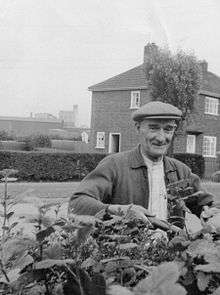George Reay

George Thompson Reay, (2 February 1900[1] – 29 May 1970[2]) was an English professional footballer who played for several British football teams during the 1920s and 1930s. After beginning his football career playing for his local colliery in the north-east of England, George went on to play for a number of established football clubs and also made some guest appearances with local teams, before retiring from the sport shortly before the outbreak of the Second World War. After retirement, he spent the rest of his life in Northamptonshire, England where he was employed as a steelworker. George's youngest brother, Ted Reay, played for Sheffield United and Queens Park Rangers.
Early life
George was born on 2 February 1900 at 16 Pit Row, East Howdon, Northumberland, the third child and first son of William Reay and Mary Thompson Peel who had married seven years previously. William was by trade an iron-ship caulker in the local dockyard and was a native of South Hylton, County Durham. Mary Thompson Peel, the great-great niece of the huntsman John Peel was native to East Howdon.
Pit Row was George's childhood home and growing up, he often played football with all of his younger brothers, who all played professionally with the exception of William Reay, who suffered debilitation manifesting as a result of an accident in his youth. When George reached a working age he laboured underground in the local Percy Main Colliery, joining their football team in the period following the end of the First World War. Between 1918 and 1923, he also played for South Shields and Blyth Spartans, before moving to Reading Town for the start of the 1923 season.
Kettering Town
George received his first real test, joining Kettering Town as an outside right in the 1924/25 season. In the 56 games he played, he scored only three goals. However that year did bring some successes; Kettering finished runners-up to Southampton Reserves in the Southern League and 5th in the East Midlands League. Then, after playing only half of the 1925/26 season (23 games, 2 goals), he was transferred to Raith Rovers for a fee of £700.
Raith Rovers
George signed for "Raith" on 6 December 1925, making his debut as an outside right thirteen days later in a 2–1 defeat to Partick Thistle. In an article written in The Post (Glasgow) on Sunday 20 December, George was heralded as playing a good game despite some trial and error footwork in accordance with adjusting to Scottish football, as opposed to that which he was used to playing south of the border.
He scored his first goal for the club on 27 February 1926 in a 2–0 victory over Clydebank,which was witnessed by a crowd of 2,000. George's goal came when he "nodded" the ball into the Clydebank goal after the ball fell in front of him.[3] His greatest moment for the club came when he scored Raith's only goal in a 1–1 draw against local rivals Dunfermline, a goal which was warmly recognised by fans, and gained George their affections and a local celebrity status.
During the 1926–1927 season, George improved further, scoring 12 goals in 36 games, including two goals in a 3–1 win over Ayr. George's efforts helped Raith Rovers to finish the season as Second Division runners-up to Bo'ness, an achievement which was rewarded with promotion for the club. The last appearance he made for them was on 18 April 1928 in the Dunedin Cup Final, an appearance which took his total with the club to 70. He was transferred on 22 May 1928 to Bristol Rovers, having contributed 19 goals for Raith Rovers over three seasons of play.
_with_the_Raith_Rovers_first_team_in_1927.jpg)
Bristol Rovers
Playing for Bristol Rovers, George played in forward position. In his two years there (1928–1929 and 1929–1930), he made 67 appearances and scored 11 times. One of these was in an impressive 3–1 win over Swindon Town who were seven places higher in the league table than Bristol Rovers.
Coventry City
Next, George's career took him to Coventry City at the end of the 1930 season. A frustrating season meant that he only managed to score three goals for the club in fifteen appearances, however his final goal came in his last appearance for them: a 2–1 win at home against Fulham on 2 May 1931.
Burton Town
George then moved to Burton Town and the seasons that followed would prove to be the highlight of his footballing career. George achieved an impressive tally with the club, scoring numerous goals and proving to be a very popular and respected member of the team. During the Bass Charity Vase final in April 1932, George helped to set up two of Burton's three goals, and scoring the remaining one.
Retirement
Returning in a care-taking capacity, George moved back to Kettering Town in 1937 and became the groundsman at Rockingham Road. After settling in nearby Weldon for a short time, he later moved to Corby where he was employed in the steelworks as an electric furnace-man.

The Reay family home still stands today at number 89 Stephenson Way.
Personal life
George died on 29 May 1970 at the age of seventy, having suffered from lung cancer. He was survived by his wife, Janet Williamson Reay, and four children. Janet was the daughter of a quarry contractor named John and came from a substantial family based in Fife. She had married George in February 1927 during the time he spent with Raith Rovers club.
"Reay Houses", situated on Bowling Green Road in Kettering, are believed to be named in his honour as a gesture of appreciation on behalf of the town for his contributions to the club.
References
- ↑ Birth Certificate of George Thompson Reay
- ↑ Death certificate of George Thompson Reay
- ↑ Article appearing in The Sunday Post on Sunday 28 February 1926.